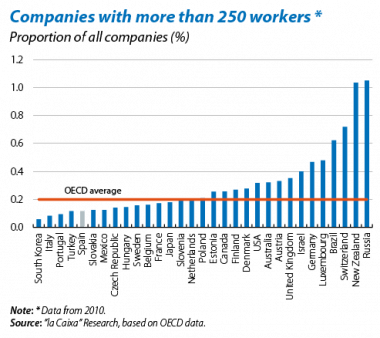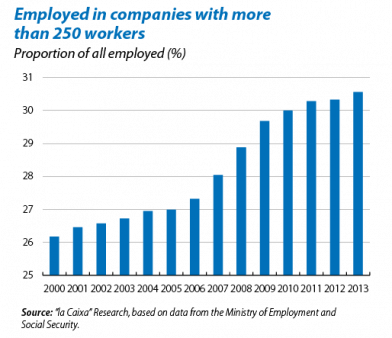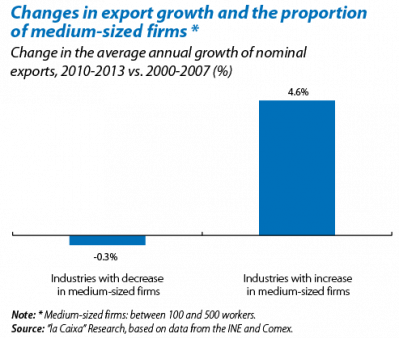Spanish firms are getting bigger
In general, the productivity of large firms is greater than that of small firms. In Spain, the gross value added per worker of companies with more than 250 employees is 65% greater than companies with fewer than 50 employees. The proportion of large firms is therefore one of the determining factors in a country's productivity: those countries with a higher proportion of their labour force in large companies usually show higher levels of productivity.
In 2010, the last year for which the OECD publishes comparable data between countries, the proportion of companies with more than 250 workers in Spain was slightly lower than that of the main developed countries. While only 0.12% of the firms in Spain had more than 250 workers, these companies accounted for 0.32% of the total in the US and 0.47% in Germany. The differences may seem small but the implications are not. While Spanish firms with more than 250 workers employed only 24.5% of employed people, in the US and Germany they gave work to 49.8% and 37.0%, respectively. However, the dynamics over the last few years have been changing this pattern in Spain.
The recession suffered by the Spanish economy has affected the whole business world but, in general, large companies were able to weather the storm better. The percentage of firms with more than 250 employees remained relatively stable up to 2007 but from then on started a clearly upward trend. Job losses were also concentrated in smaller companies while the number of workers in large firms has actually been posting a year-on-year positive growth rate for the last six months. The percentage of employed people in a company with more than 250 workers in April was 3.5 p.p. higher than in 2006.1
This relatively better trend for larger companies has been helped by the foreign sector's good performance. According to data from the SEPI foundation, in 2011 92.5% of manufacturing companies with more than 200 employees exported their products, while only 61.1% of those with fewer than 200 employees were exporting. It therefore comes as no surprise that those industries with a bigger number of large companies have seen the highest growth in exports over the last few years. It is interesting to note, however, that medium-sized firms are also taking advantage of the boost provided by the foreign sector. Although data are still not available to verify this properly, it can be observed that, in industries where the proportion of medium-sized firms has grown the most, so have exports over the last few years. An encouraging trend for Spain to extend its more productive corporate base.
1. Data not comparable with those from the OECD, which focuses its analysis on market sectors and includes the number of self-employed workers.


